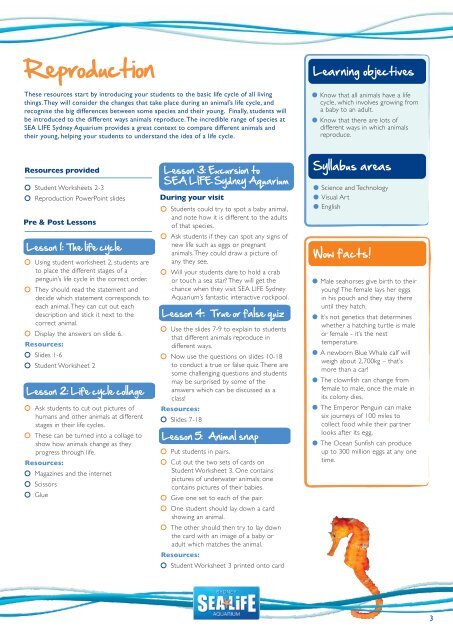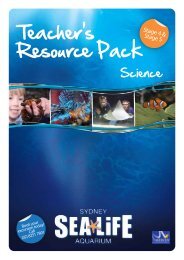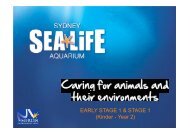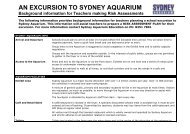Teacher's Resource Pack - Sydney Aquarium
Teacher's Resource Pack - Sydney Aquarium
Teacher's Resource Pack - Sydney Aquarium
Create successful ePaper yourself
Turn your PDF publications into a flip-book with our unique Google optimized e-Paper software.
Reproduction<br />
These resources start by introducing your students to the basic life cycle of all living<br />
things. They will consider the changes that take place during an animal’s life cycle, and<br />
recognise the big differences between some species and their young. Finally, students will<br />
be introduced to the different ways animals reproduce. The incredible range of species at<br />
SEA LIFE <strong>Sydney</strong> <strong>Aquarium</strong> provides a great context to compare different animals and<br />
their young, helping your students to understand the idea of a life cycle.<br />
Learning objectives<br />
● Know that all animals have a life<br />
cycle, which involves growing from<br />
a baby to an adult.<br />
● Know that there are lots of<br />
different ways in which animals<br />
reproduce.<br />
<strong>Resource</strong>s provided<br />
Student Worksheets 2-3<br />
Reproduction PowerPoint slides<br />
Pre & Post Lessons<br />
Lesson 1: The life cycle<br />
Using student worksheet 2, students are<br />
to place the different stages of a<br />
penguin’s life cycle in the correct order.<br />
They should read the statement and<br />
decide which statement corresponds to<br />
each animal. They can cut out each<br />
description and stick it next to the<br />
correct animal.<br />
Display the answers on slide 6.<br />
<strong>Resource</strong>s:<br />
Slides 1-6<br />
Student Worksheet 2<br />
Lesson 2: Life cycle collage<br />
Ask students to cut out pictures of<br />
humans and other animals at different<br />
stages in their life cycles.<br />
These can be turned into a collage to<br />
show how animals change as they<br />
progress through life.<br />
<strong>Resource</strong>s:<br />
Magazines and the internet<br />
Scissors<br />
Glue<br />
Lesson 3: Excursion to<br />
SEA LIFE <strong>Sydney</strong> <strong>Aquarium</strong><br />
During your visit<br />
Students could try to spot a baby animal,<br />
and note how it is different to the adults<br />
of that species.<br />
Ask students if they can spot any signs of<br />
new life such as eggs or pregnant<br />
animals. They could draw a picture of<br />
any they see.<br />
Will your students dare to hold a crab<br />
or touch a sea star? They will get the<br />
chance when they visit SEA LIFE <strong>Sydney</strong><br />
<strong>Aquarium</strong>’s fantastic interactive rockpool.<br />
Lesson 4: True or false quiz<br />
Use the slides 7-9 to explain to students<br />
that different animals reproduce in<br />
different ways.<br />
Now use the questions on slides 10-18<br />
to conduct a true or false quiz. There are<br />
some challenging questions and students<br />
may be surprised by some of the<br />
answers which can be discussed as a<br />
class!<br />
<strong>Resource</strong>s:<br />
Slides 7-18<br />
Lesson 5: Animal snap<br />
Put students in pairs.<br />
Cut out the two sets of cards on<br />
Student Worksheet 3. One contains<br />
pictures of underwater animals; one<br />
contains pictures of their babies.<br />
Give one set to each of the pair.<br />
One student should lay down a card<br />
showing an animal.<br />
The other should then try to lay down<br />
the card with an image of a baby or<br />
adult which matches the animal.<br />
<strong>Resource</strong>s:<br />
Student Worksheet 3 printed onto card<br />
Syllabus areas<br />
● Science and Technology<br />
● Visual Art<br />
● English<br />
Wow facts!<br />
● Male seahorses give birth to their<br />
young! The female lays her eggs<br />
in his pouch and they stay there<br />
until they hatch.<br />
● It’s not genetics that determines<br />
whether a hatching turtle is male<br />
or female - it’s the nest<br />
temperature.<br />
● A newborn Blue Whale calf will<br />
weigh about 2,700kg – that’s<br />
more than a car!<br />
● The clownfish can change from<br />
female to male, once the male in<br />
its colony dies.<br />
● The Emperor Penguin can make<br />
six journeys of 100 miles to<br />
collect food while their partner<br />
looks after its egg.<br />
● The Ocean Sunfish can produce<br />
up to 300 million eggs at any one<br />
time.<br />
3








